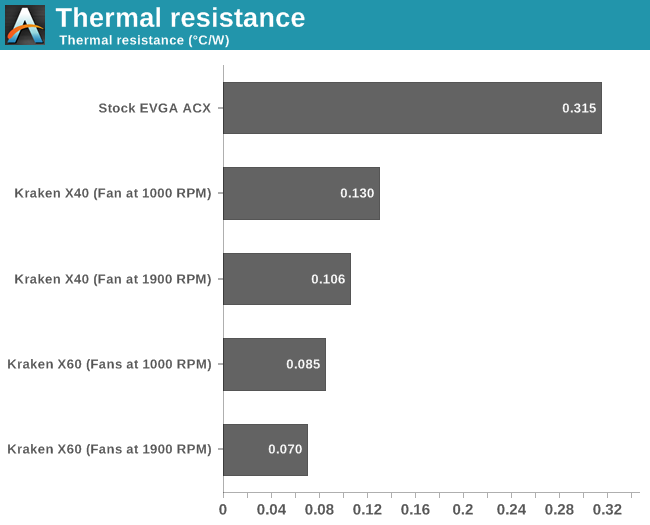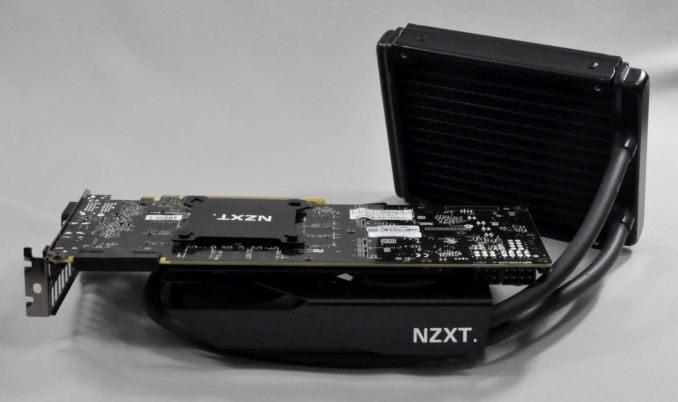NZXT Kraken G10 Review: Liquid Cooling for Your GPU
by E. Fylladitakis on March 11, 2014 1:15 AM EST- Posted in
- Cases/Cooling/PSUs
- NZXT
- Water Cooling
- Kraken
- G10
Performance Results
In order to assess the potential of the Kraken G10, we tested it on an EVGA GTX 770 ACX, a high performance graphics card with a good stock air-cooling solution. Testing is performed with the two cooling kits NZXT currently offers, the Kraken X40 (single 140mm) and the Kraken X60 (dual 140mm). In order to stress the GPU core to the maximum, we ran a cryptocoin mining algorithm at maximum intensity and allocation, a method that displayed considerably greater power draw (224W) than any 3D benchmark (≈174W during a Unigine Heaven run). It has the added benefit of being rather consistent in it's load.


NZXT claims that the Kraken G10 can yield up to a 40% increase in performance (cooling), which isn't phrased quite right. The actual performance difference of cooling solutions is properly calculated by comparing the °C/W performance ratings, not just by comparing temperatures. While saying, "80°C to 45°C – oh, that's 44% lower temperatures" is factually correct, it doesn't account for the power element and since temperature (Celsius) is not zero based, there are (many) problems with only looking at temperatures. More properly, a 50% reduction in the temperature change over ambient would equate to a 100% increase in cooling performance, and a 100% reduction in temperature change over ambient would mean driving the equipment at below ambient temperatures, which is obviously impossible without specialized cooling (e.g. thermoelectric coolers).
According to our performance testing shown in the charts above, the stock cooler has a performance rating of about 0.315 °C/W, which is a good rating for a stock air-cooler. However, even the worst result for the G10, that of using a Kraken X40 with the fan at 1000RPM, displays a performance rating of 0.13 °C/W. In that case, the thermal performance is over 58% lower. The best performing configuration we tested, that of a Kraken X60 with its fans at maximum speed, has a performance rating of about 0.07 °C/W, a 77% reduction in thermal resistance over the stock cooler. Put another way, the stock cooler has thermal resistance that's 350% higher (worse) than the X60 with fans at 1900RPM – impressive!
Conclusion
Being nothing more than a steel bracket, the Kraken G10 essentially is a very simple product, yet it displays tremendous potential. One can wonder why no one else thought of this before (or at least, no one released a product like this until now), as Asetek's kits have been available for years. A liquid-cooling kit, even with its fan running at minimum speed, offers immensely better thermal performance than the stock air-coolers of modern graphics cards. This is especially good news for users that are trying to build low noise systems, as the stock coolers of high performance graphics cards are often difficult to deal with.
However, as convenient as the Kraken G10 may appear, there are some obvious limitations. One such limitation is that the fans of the liquid-cooling kit cannot be thermally controlled in relation to the temperatures of the graphics card. When installing such a kit on the CPU, the fans can be thermally controlled by the motherboard, but that's not an option here. Although fan control is partially possible for the kits with USB interfaces, such as the Kraken X40/X60 that were used for this review, this control is limited to the predefined settings of the user and does not adjust automatically depending on the load of the card.
Furthermore, even though the included 92mm fan takes care of the problem, liquid-cooling is limited to the GPU core alone. Custom liquid-cooling kits can implement the use of full coverage cooling blocks, cooling the entire card rather than just the GPU; however, even if we neglect all other disadvantages that custom liquid-cooling setups have, a single such block usually costs more than an entire closed-loop kit plus the Kraken G10 bracket.
Finally, in order to be useful you need a case with a radiator mounting point near the card itself, such as at the bottom of the case or on the HDDs cage(s), as the hoses of typical closed-loop are limited in length. It is unlikely that the radiator will reach the top or front panel in all but the smallest of cases, and multiple graphics card setups will only be possible in specific case designs.
Despite these limitations however, the NZXT Kraken G10 remains a very appealing product. NZXT took the simplest of ideas, carried it through to fruition, and brought it to the market as a $30 USD product that (currently) has zero competition. It is a product that we would highly recommend to anyone who has a proper case and wants better cooling for a high-end graphics card without the cost and complexity of a customized water cooling kit.











61 Comments
View All Comments
Bansaku - Tuesday, March 11, 2014 - link
Uhm, my Zalman CNPS20LQ (Asetek) pump is extremely quiet. In fact, no fan I have ever put in a case has been as quiet as most AIO coolers (from Asetek). I don't know where you get the idea that pumps are inherently noisier. Perhaps pumps from DIY kits.joelslaw - Tuesday, March 11, 2014 - link
Am I the only one who doesn't see a gallery on page 2? It says: "The installation of the Kraken X40 kit with the aid of the Kraken G10 on an EVGA GTX770 is depicted in the gallery below." but I only see 1 image below that.Redmenace - Tuesday, March 11, 2014 - link
Bottom line for the doubters...I had a 7950 in xfire on the top slot, overclocked and overvolted, which ran hot and 3000rpm loud and still hitting 80C. Installed this bracket with an X40 and just slapped the radiator on one of the existing 140mm case intake fans running at a constant 800rpm. Believe me, dumping two 92mm fans turning 3000rpm and replacing it with a 92mm fan (for the VRM's) running about 1300 is much quieter. Did not install any VRM heatsinks. Just adjusted the fan speed on the G10 fan enough to keep temps in the ballpark of the lower, cooler running 7950.biostud - Tuesday, March 11, 2014 - link
"Being nothing more than a steel bracket, the Kraken G10 essentially is a very simple product, yet it displays tremendous potential. One can wonder why no one else thought of this before (or at least, no one released a product like this until now)"Uhm, the Accelero hybrid which has been review on AnandTech in 2012 seems like a very similar product.
http://www.anandtech.com/show/6531/arctic-cooling-...
samsp99 - Tuesday, March 11, 2014 - link
I have wondered for a while why haven't the graphics card companies had any models with a built-in closed loop cooling solution? There are a couple of top end cards available with a water block, but nothing out of the box with a closed loop solution. The standard PC case design seems to be pretty bad from an airflow perspective for graphics cards, particularly for multiple cards. The cooling design seems to be one of the distinguishing factors between manufacturers, so having a closed loop option would seem to be a good idea. Fans on graphics cards seem to always be the noisiest and first to die in a build.Having a built in solution would allow for better fan/pump control so that they could adapt to the workload on the card.
Will Robinson - Tuesday, March 11, 2014 - link
Probably should've tried it on GTX480...that would have been a real torture test.NGR_ - Wednesday, March 12, 2014 - link
1 - Can AIO watercoolers made for 90W TDP CPU reliably cool ~250W TDP GPUs ?2 - In a case like a Fractal Design Define Mini (http://www.fractal-design.com/home/product/cases/d... where should the AIO watercooler be placed ?
3 - The G10 being out of stock, does anybody know if or when NZXT will be shipping new batches, or if other companies are preparing similar products (AIO watercoolers adaptors like the G10, or AIO GPU + watercooler) ?
E.Fyll - Wednesday, March 12, 2014 - link
1. TDP is a meaningless number in such cases. Some of these kits have a very good °C/W ratio. For exact performance figures, please refer to our AIO kit roundup. We tested all kits in that roundup with a real constant thermal load of up to 340 Watts. It would be fairly easy to assess the temperature of the card you would like to install a kit on by checking the °C/W rating of that kit and the estimated energy consumption of the card. Then, simply multiply the figures. For instance, if the kit has a thermal resistance of 0.1 °C/W and the card has an estimated power drain of 200 Watts, then the temperature will rise 0.1 × 200 = 20 °C above ambient.2. Well, depending on which AIO kit you will buy...wherever you like. I cannot possibly make an assessment for every environment, every case "like the Define Mini" and for every kit possible.
3. That I cannot answer, sorry.
JBVertexx - Wednesday, March 12, 2014 - link
The just announced Fractal Design Node 804 seems perfect for a dual-gpu completely water-cooled configuration using this adapter, although that's a lot of dough needed for 3 CLCs plus 2 of these brackets.http://www.fractal-design.com/home/product/cases/n...
theNiZer - Tuesday, March 18, 2014 - link
E. Fylladitakis : Nice review, but I don't get your point when you write: "One such limitation is that the fans of the liquid-cooling kit cannot be thermally controlled in relation to the temperatures of the graphics card. When installing such a kit on the CPU, the fans can be thermally controlled by the motherboard, but that's not an option here. Although fan control is partially possible for the kits with USB interfaces, such as the Kraken X40/X60 that were used for this review, this control is limited to the predefined settings of the user and does not adjust automatically depending on the load of the card."X40/X60 works the way you (and I) want - when the GPU heats the watercooling unit, the fans starts spinning more automatically. How is that not automatic and just like the way it works, had it been controlled by the motherboard??